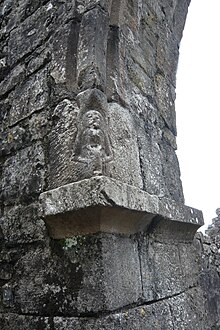
An abbey is a type of monastery used by members of a religious order under the governance of an abbot or abbess. Abbeys provide a complex of buildings and land for religious activities, work, and housing of Christian monks and nuns.
The Culdees were members of ascetic Christian monastic and eremitical communities of Ireland, Scotland, Wales and England in the Middle Ages. Appearing first in Ireland and then in Scotland, subsequently attached to cathedral or collegiate churches; they lived in monastic fashion though not taking monastic vows.

In Christianity, an anchorite or anchoret is someone who, for religious reasons, withdraws from secular society to be able to lead an intensely prayer-oriented, ascetic, or Eucharist-focused life. Anchorites are frequently considered to be a type of hermit, but unlike hermits, they were required to take a vow of stability of place, opting for permanent enclosure in cells often attached to churches. Also unlike hermits, anchorites were subject to a religious rite of consecration that closely resembled the funeral rite, following which they would be considered dead to the world and a type of living saint. Anchorites had a certain autonomy, as they did not answer to any ecclesiastical authority apart from bishops.
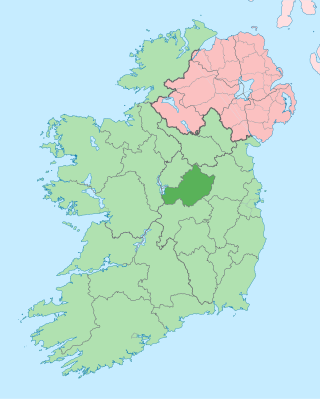
County Westmeath is a county in Ireland. It is in the province of Leinster and is part of the Eastern and Midland Region. It formed part of the historic Kingdom of Meath, which was named Mide because the kingdom was located in the geographical centre of Ireland. Westmeath County Council is the administrative body for the county, and the county town is Mullingar. At the 2022 census, the population of the county was 95,840.

Castlepollard is a village in north County Westmeath, Republic of Ireland. It lies west of Lough Lene and northeast of Lough Derravaragh and Mullingar.

Ballysadare, locally also Ballisodare, is a town in County Sligo, Ireland. It is about 7 km (4 mi) south of Sligo town. The town developed on an important crossing of the Owenmore River. Ballysadare is in a townland and civil parish of the same name.
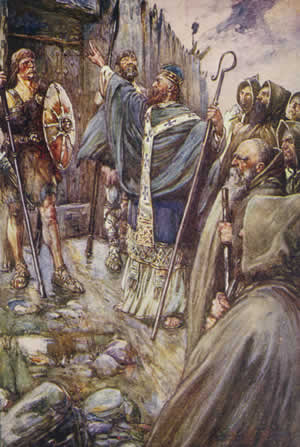
The Hiberno-Scottish mission was a series of expeditions in the 6th and 7th centuries by Gaelic missionaries originating from Ireland that spread Celtic Christianity in Scotland, Wales, England and Merovingian France. Catholic Christianity spread first within Ireland. Since the 8th and 9th centuries, these early missions were called 'Celtic Christianity'.

Termonfeckin or Termonfechin is a small village and townland in County Louth, Ireland. It is within a civil parish of the same name, and is 8 km (5.0 mi) north-east of Drogheda. The population of the village almost quadrupled in the period between the 1996 and 2022 census, growing from 530 to 1,983 inhabitants.
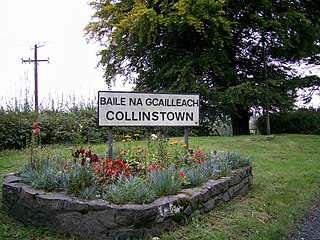
Collinstown is a village in north County Westmeath, situated on the R395 regional road overlooking Lough Lene. It lies 18 km (11 mi) northeast of the county town of Mullingar and had a population of 356.
Lough Lene Gaels is a Gaelic Athletic Association club, based in Collinstown, County Westmeath, Ireland.
The Lough Lene Boat, also known as The Monks' Boat, is an underwater archaeological artifact from prehistoric Ireland. It was discovered in 1968 on the east side of Lough Lene, County Westmeath nearest to the Cummerstown/Windtown townlands of Collinstown. Radiocarbon dating revealed that the boat was constructed sometime between the 1st and 4th century.

Saint Féchín or Féichín, also known as Mo-Ecca, was a 7th-century Irish saint, chiefly remembered as the founder of the monastery at Fore (Fobar), County Westmeath.

Fore is a village, next to the old Benedictine Abbey ruin of Fore Abbey, situated to the north of Lough Lene in County Westmeath, in Ireland.
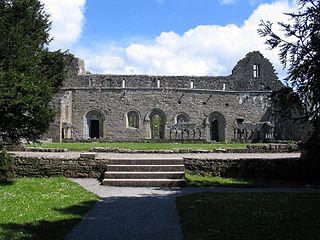
Cong Abbey also known as the Royal Abbey of Cong, is a historic site located at Cong, County Mayo, in Ireland's province of Connacht. The ruins of the former Augustinian abbey mostly date to the 13th century and have been described as featuring some of finest examples of medieval ecclesiastical architecture in Ireland.
Ó Beigléighinn or Beglin was the name of a hereditary medical family of County Longford.

St Mary Magdalene was a Benedictine priory in Lincoln, England. Along with Sandtoft Priory and Hanes Cell, it was a Lincolnshire cell of St Mary's Abbey in York, England. A surviving building, once owned by the priory, is Monks' Abbey, Lincoln.

Rumburgh Priory was a Benedictine priory located in the village of Rumburgh in the English county of Suffolk. The priory was founded in about 1065 as a cell of St Benet's Abbey at Hulme in Norfolk. At the time of the Domesday Book in 1086 it had 12 monks. The ownership of the priory was transferred to St Mary's Abbey in York towards the end of the 12th century. The monks of Rumburgh were particularly devoted to St. Bee, whom they commemorated at Michaelmas.

Fore is a barony in northern County Westmeath, Ireland. It was formed by 1672.
Gilla an Choimded Ó Duillénnáin was an Irish cleric.

Rathgarve, is a civil parish, religious parish, and townland, in County Westmeath, Ireland. It is located about 19.24 kilometres (12 mi) north of Mullingar. It takes in parts of the modern town of Castlepollard, and it forms part of the religious parish of St. Michael's Parish, Castlepollard. Historically it has been linked to the 8th century monk Dicuil, according to Monasticon Hibernicum. However, he is also associated with Rathgar, in Dublin, which may indicate a misassociation with one of these sites.


